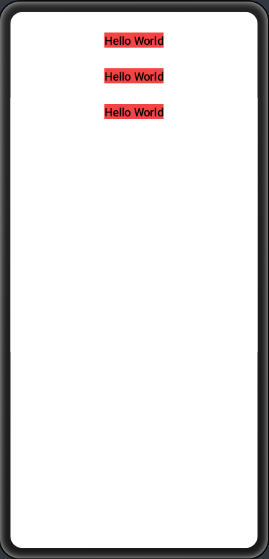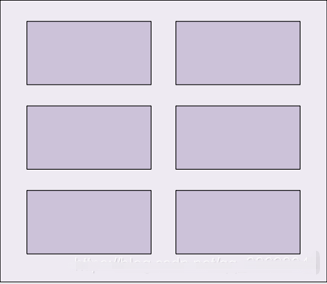【中软国际】HarmonyOS 基础之 UI 布局(一) 精华
概述
华为鸿蒙系统是一款全新的面向全场景的分布式操作系统,基于 harmony 的应用开发也越来越广泛。鸿蒙系统是否也能开发出像安卓平台一样绚丽多彩的应用 UI 界面呢?通过对 android UI 已有知识的回顾和最近 harmony 应用开发的学习研究,我总结了一篇UI框架开发文档,记录一些开发中可能遇到的小问题和有用的小技巧分享给大家。
常用布局
一、DirectionalLayout 布局
DirectionalLayout 布局即方向布局,该种分为两种模式 ( vertical ) 垂直排列子元素,( horizontal ) 水平排列子元素。垂直排列子元素 height 的总和不得超过父元素否则会被截取,超过部分无法显示。同理水平排列子元素 width 的总和如果超过父元素也会被截取。
水平排列和垂直排列通过设置 ohos:orientation 属性定义,ohos:orientation = " vertical " 为垂直排列,ohos:orientation = " horizontal" 为水平排列;
1、垂直排列
<?xml version="1.0" encoding="utf-8"?>
<DirectionalLayout
xmlns:ohos="http://schemas.huawei.com/res/ohos"
ohos:width="match_parent"
ohos:height="match_parent"
// 垂直排列
ohos:orientation="vertical">
<Text
ohos:text="$string:HelloWorld"
ohos:width="match_content"
ohos:height="match_content"
ohos:text_size="50"
ohos:top_margin="30fp"
ohos:background_element="#f54444"
ohos:layout_alignment="horizontal_center"/>
<Text
ohos:text="$string:HelloWorld"
ohos:width="match_content"
ohos:height="match_content"
ohos:text_size="50"
ohos:top_margin="30fp"
ohos:background_element="#f54444"
ohos:layout_alignment="horizontal_center"/>
<Text
ohos:text="$string:HelloWorld"
ohos:width="match_content"
ohos:height="match_content"
ohos:text_size="50"
ohos:top_margin="30fp"
ohos:background_element="#f54444"
ohos:layout_alignment="horizontal_center"/>
</DirectionalLayout>
如上代码为垂直方向的三个textview布局,效果图如下:

2、水平排列
<?xml version="1.0" encoding="utf-8"?>
<DirectionalLayout
xmlns:ohos="http://schemas.huawei.com/res/ohos"
ohos:width="match_parent"
ohos:height="match_parent"
// 水平排列
ohos:orientation="horizontal">
<Text
ohos:text="$string:HelloWorld"
ohos:width="match_content"
ohos:height="match_content"
ohos:text_size="50"
ohos:top_margin="30fp"
ohos:left_margin="10fp"
ohos:background_element="#f54444"
ohos:layout_alignment="horizontal_center"/>
<Text
ohos:text="$string:HelloWorld"
ohos:width="match_content"
ohos:height="match_content"
ohos:text_size="50"
ohos:top_margin="30fp"
ohos:left_margin="10fp"
ohos:background_element="#f54444"
ohos:layout_alignment="horizontal_center"/>
<Text
ohos:text="$string:HelloWorld"
ohos:width="match_content"
ohos:height="match_content"
ohos:text_size="50"
ohos:top_margin="30fp"
ohos:left_margin="10fp"
ohos:background_element="#f54444"
ohos:layout_alignment="horizontal_center"/>
</DirectionalLayout>
如上代码为水平方向的三个textview布局,效果图如下:

3、对齐方式
DirectionalLayout 中的组件使用 layout_alignment 控制自身在布局中的对齐方式,当对齐方式与排列方式方向一致时,对齐方式不会生效具体见下表。
| 参数 | 作用 | 可搭配排列方式 |
|---|---|---|
| left | 左对齐 | 垂直排列 |
| top | 顶部对齐 | 水平排列 |
| right | 右对齐 | 垂直排列 |
| bottom | 底部对齐 | 水平排列 |
| horizontal_center | 水平方向居中 | 垂直排列 |
| vertical_center | 垂直方向居中 | 水平排列 |
| center | 垂直与水平方向都居中 | 水平/垂直排列 |
三种基本对齐方式:左对齐,右对齐,居中。分别对应 layout_alignment 属性的
ohos:layout_alignment=“left”
ohos:layout_alignment=“horizontal_center”
ohos:layout_alignment=“right”
布局展示的样式为:

4、权重
权重( weight )就是按比例来分配组件占用父组件的大小,通过 ohos:weight 属性来定义。布局计算公式为:组件宽度=组件weight/所有组件weight之和*父布局可分配宽度;如 ohos:weight 分别设置为 ohos:weight = “1”,ohos:weight = “2”,ohos:weight = "3"的三个空间,布局则分别占父空间的1/6 , 2/6 , 3/6 。
<?xml version="1.0" encoding="utf-8"?>
<DirectionalLayout
xmlns:ohos="http://schemas.huawei.com/res/ohos"
ohos:width="match_parent"
ohos:height="match_parent"
ohos:orientation="horizontal">
<Text
ohos:text="TEST"
ohos:weight="1"
ohos:width="match_content"
ohos:height="match_content"
ohos:text_size="50"
ohos:top_margin="30fp"
ohos:background_element="#f78731"/>
<Text
ohos:text="TEST"
ohos:weight="2"
ohos:width="match_content"
ohos:height="match_content"
ohos:text_size="50"
ohos:top_margin="30fp"
ohos:background_element="#f54444"/>
<Text
ohos:text="TEST"
ohos:weight="3"
ohos:width="match_content"
ohos:height="match_content"
ohos:text_size="50"
ohos:top_margin="30fp"
ohos:background_element="#f78731"/>
</DirectionalLayout>
以上代码展示的布局效果图如下:

二、DependentLayout 布局
DependentLayout 与 DirectionalLayout相比,拥有更多的排布方式,每个组件可以指定相对于其他同级元素的位置,或者指定相对于父组件的位置。
1、相对于同级组件的位置布局
| 位置布局 | 描述 |
|---|---|
| above | 处于同级组件的上侧。 |
| below | 处于同级组件的下侧。 |
| start_of | 处于同级组件的起始侧。 |
| end_of | 处于同级组件的结束侧。 |
| left_of | 处于同级组件的左侧。 |
| right_of | 处于同级组件的右侧。 |
2、相对于父组件的位置布局
| 位置布局 | 描述 |
|---|---|
| align_parent_left | 处于父组件的左侧。 |
| align_parent_right | 处于父组件的右侧。 |
| align_parent_start | 处于父组件的起始侧。 |
| align_parent_end | 处于父组件的结束侧。 |
| align_parent_top | 处于父组件的上侧。 |
| align_parent_bottom | 处于父组件的下侧。 |
| center_in_parent | 处于父组件的中间。 |
DependentLayout 布局类似于 Android 的 RelativeLayout 比较灵活,具体怎么展示和调整组件布局可自行测试。
三、TableLayout 布局
TableLayout使用表格的方式划分子组件, 也就是行和列的方式,TableLayout可配置表格的排列方式,行数和列数,以及组件的位置。
1、行列的设置
ohos:row_count 表示设置网格布局中行数,ohos:column_count 表示设置网格布局中的列数。如果没有为子布局设置行列数,则自动继承父布局的行数和列数。在网格布局中若子组件的数量超出列数设置,则会自动添加行数。比如设置一行,两列,但是是三个子组件,行数设置失效,就会自动增加一行。如下设置三行两列。则布局就是如下展示。
<TableLayout
...
ohos:row_count="3"
ohos:column_count="2"
/>

2、设置对齐方式
通过属性 ohos:alignment_type 来设置对齐方式,如下:
<TableLayout
...
ohos:alignment_type="align_contents">
...
</TableLayout>
| 属性值 | 效果 |
|---|---|
| align_edges | 表示子组件边界对齐,默认对齐方式。 |
| align_contents | 表示子组件边距对齐。 |
四、StackLayout
StackLayout 直接在屏幕上开辟出一块空白的区域,添加到这个布局中的视图都是以层叠的方式显示,而它会把这些视图默认放到这块区域的左上角,第一个添加到布局中视图显示在最底层,最后一个被放在最顶层。上一层的视图会覆盖下一层的视图。
<?xml version="1.0" encoding="utf-8"?>
<StackLayout
xmlns:ohos="http://schemas.huawei.com/res/ohos"
ohos:id="$+id:stack_layout"
ohos:height="match_parent"
ohos:width="match_parent">
<Text
ohos:id="$+id:text_blue"
ohos:text_alignment="bottom|horizontal_center"
ohos:text_size="24fp"
ohos:text="第一层"
ohos:height="400vp"
ohos:width="400vp"
ohos:background_element="#3F56EA" />
<Text
ohos:id="$+id:text_light_purple"
ohos:text_alignment="bottom|horizontal_center"
ohos:text_size="24fp"
ohos:text="第二层"
ohos:height="300vp"
ohos:width="300vp"
ohos:background_element="#00AAEE" />
<Text
ohos:id="$+id:text_orange"
ohos:text_alignment="center"
ohos:text_size="24fp"
ohos:text="第三层"
ohos:height="80vp"
ohos:width="80vp"
ohos:background_element="#00BFC9" />
</StackLayout>
以上代码效果图如下:

更多原创内容请关注: 中软国际 HarmonyOS 技术学院
在研发和使用过程中关于组件的扩展、移植,复用及数据结构和算法等问题,欢迎各位研发小伙伴交流讨论,让我们一起携手前行共建鸿蒙生态。




















